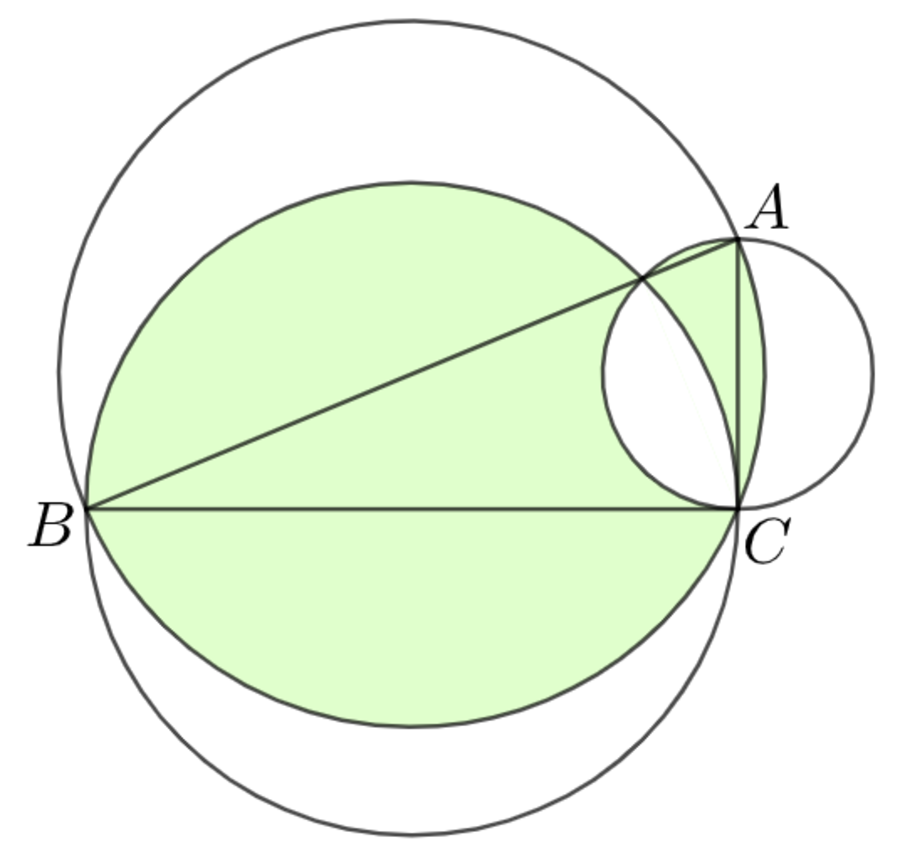Fishy Information

The three circles overlap each other, such that points are their intersection points as shown above. It is known that triangle has side lengths and . In addition, all its sides represent the respective diameters of the circles.
If the area sum of the green region can be expressed as
where are positive integers, and is square-free, input as your answer.
The answer is 19.
This section requires Javascript.
You are seeing this because something didn't load right. We suggest you, (a) try
refreshing the page, (b) enabling javascript if it is disabled on your browser and,
finally, (c)
loading the
non-javascript version of this page
. We're sorry about the hassle.
Let D , E , and F be the centers of each circle, and let G be the other intersection point of circles:
Since A B , A C , and B C are diameters, by Thales's Theorem ∠ A C B = ∠ A G C = ∠ B G C = 9 0 ° , which means △ A B C ∼ △ A C G ∼ △ C B G by AA similarity.
The area of △ A B C is A △ A B C = 2 1 ⋅ B C ⋅ A C = 2 1 ⋅ ( 1 + 2 ) ⋅ 1 = 2 1 + 2 .
By the Pythagorean Theorem on △ A B C , A B = A C 2 + B C 2 = ( 1 + 2 ) 2 + 1 2 = 4 + 2 2 .
Also from △ A B C , ∠ A B C = tan − 1 B C A C = tan − 1 1 + 2 1 = 2 2 . 5 ° , and its central angle ∠ A F C = 2 ⋅ 2 2 . 5 ° = 4 5 ° .
By similar triangles, ∠ A B C = ∠ A C G = ∠ C B G = 2 2 . 5 ° , so central angles ∠ A E G = ∠ C D G = 4 5 ° .
Let the A G C 1 be the area between G C and the arc G C (on the right side). As a difference between sector C D G and △ C D G ,
A G C 1 = 3 6 0 ° ∠ C D G ⋅ π ⋅ C D 2 − 2 1 ⋅ C D 2 ⋅ sin ∠ C D G = 3 6 0 ° 4 5 ° ⋅ π ⋅ ( 2 1 + 2 ) 2 − 2 1 ⋅ ( 2 1 + 2 ) 2 ⋅ sin 4 5 ° = ( 8 1 π − 4 2 ) ( 4 3 + 2 2 )
Similarly,
A B G = 3 6 0 ° ∠ B D G ⋅ π ⋅ B D 2 − 2 1 ⋅ B D 2 ⋅ sin ∠ B D G = 3 6 0 ° 1 3 5 ° ⋅ π ⋅ ( 2 1 + 2 ) 2 − 2 1 ⋅ ( 2 1 + 2 ) 2 ⋅ sin 1 3 5 ° = ( 8 3 π − 4 2 ) ( 4 3 + 2 2 )
A A G = 3 6 0 ° ∠ A E G ⋅ π ⋅ A E 2 − 2 1 ⋅ A E 2 ⋅ sin ∠ A E G = 3 6 0 ° 4 5 ° ⋅ π ⋅ ( 2 1 ) 2 − 2 1 ⋅ ( 2 1 ) 2 ⋅ sin 4 5 ° = ( 8 1 π − 4 2 ) ( 4 1 )
A G C 2 = 3 6 0 ° ∠ C E G ⋅ π ⋅ E C 2 − 2 1 ⋅ E C 2 ⋅ sin ∠ C E G = 3 6 0 ° 1 3 5 ° ⋅ π ⋅ ( 2 1 ) 2 − 2 1 ⋅ ( 2 1 ) 2 ⋅ sin 1 3 5 ° = ( 8 3 π − 4 2 ) ( 4 1 )
A A C = 3 6 0 ° ∠ A F C ⋅ π ⋅ A F 2 − 2 1 ⋅ A F 2 ⋅ sin ∠ A F C = 3 6 0 ° 4 5 ° ⋅ π ⋅ ( 2 4 + 2 2 ) 2 − 2 1 ⋅ ( 2 4 + 2 2 ) 2 ⋅ sin 4 5 ° = ( 8 1 π − 4 2 ) ( 4 4 + 2 2 )
A B C = 3 6 0 ° ∠ B F C ⋅ π ⋅ B F 2 − 2 1 ⋅ B F 2 ⋅ sin ∠ B F C = 3 6 0 ° 1 3 5 ° ⋅ π ⋅ ( 2 4 + 2 2 ) 2 − 2 1 ⋅ ( 2 4 + 2 2 ) 2 ⋅ sin 1 3 5 ° = ( 8 3 π − 4 2 ) ( 4 4 + 2 2 )
The area of the green region is then A green = A △ A B C − A G C 1 − A G C 2 + A B G + A A G + A A C + A B C = 8 1 ( 5 + 3 2 ) π .
Therefore, A = 1 , B = 8 , C = 5 , D = 3 , E = 2 , and A + B + C + D + E = 1 9 .